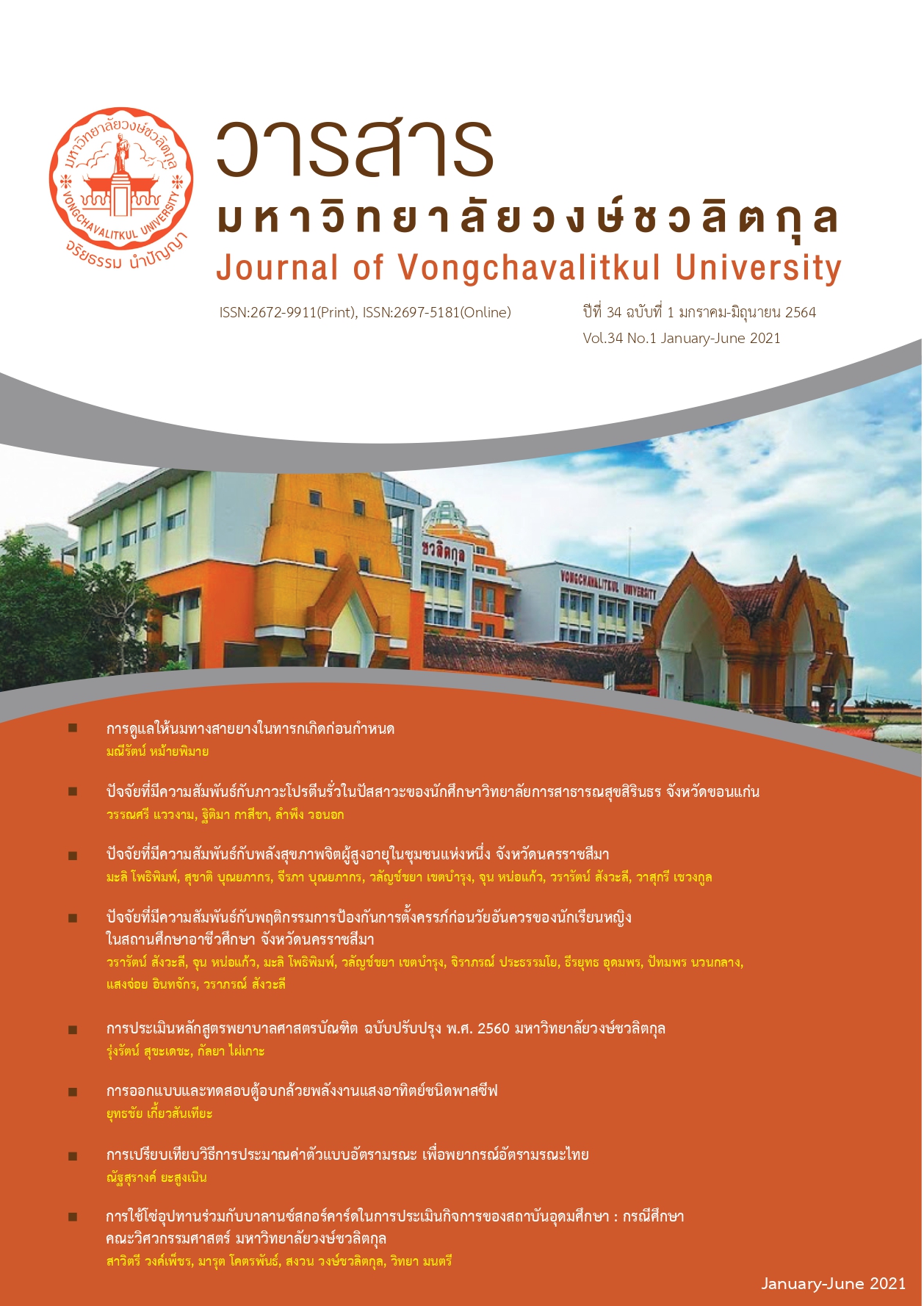Design and Testing of a Passive Solar Dryer for Banana Drying
Main Article Content
Abstract
Objective: This research objective was to study the design, construction and testing of a passive solar dryer for banana drying to suit the use of agriculturists. The solar dryer must decrease the moisture content of the bananas to between approximately 10 and 20 percent.
Methods: The passive solar dryer that was designed and built had a transparent chamber with the dimensions of 0.8 × 1 × 1 m. The chimney was 0.2 meters in diameter,
1 meter in height, and was installed at the top of the drying room to increase air circulation
from the drying room to the outside. The solar collector, which the dimension was 0.8 × 1.25 × 0.05 meters, was installed in front of the drying room to increase the air temperature through the solar collector into the drying room.
Results: The experimental results showed that the solar collector could increase the temperature at the entrance of the drying room to an average of 55 degrees Celsius, when the average ambient temperature was 35 degrees Celsius, and the average temperature inside the drying room was 53 degrees Celsius. Drying test was performed on 5 kg bananas on each testing. The bananas used in the test had 80 percent initial moisture content. To obtain 10 to 20 percent moisture content, the drying time was 36 hours at 526 watts of solar power per square meter. The dried bananas weighed 1.565 kg containing 11.28 percent moisture content, which was suitable for storage. It also saved time in drying bananas compared to traditional bananas drying.
Article Details
References
2. กรมพัฒนาพลังงานทดแทนและอนุรักษ์พลังงาน. (2563). แผนพัฒนาพลังงานทดแทนและพลังงานทางเลือก พ.ศ. 2561–2580. (น. 6). กระทรวงพลังงาน. สืบค้น 2 กุมภาพันธ์ 2564, จาก https://www.dede.go.th/download/Plan_62/20201021_TIEB_AEDP2018.pdf.
3. กองถ่ายทอดและเผยแพร่เทคโนโลยี กรมพัฒนาพลังงานทดแทนและอนุรักษ์พลังงาน. (2563). การผลิตความร้อนจากพลังงานแสงอาทิตย์ การถ่ายทอดและการใช้พลังงานแสงอาทิตย์. (น. 21-40). กระทรวงพลังงาน. สืบค้น 2 กุมภาพันธ์ 2564, จาก http://webkc.dede.go.th/testmax/sites/default/files/คู่มือการผลิตความร้อนจากพลังงานแสงอาทิต_ปก_0.pdf.
4. จารุวัฒน์ เจริญจิต. (2555). เทคโนโลยีการอบแห้งด้วยรังสีอาทิตย์ และแนวทางการพัฒนา. วารสารวิจัย มข, 17(1), 110-124. สืบค้น 11 ตุลาคม พ.ศ. 2563, จาก https://resjournal.kku.ac.th
5. จันทร์เพ็ญ บุตรใส และ เสน่ห์ บัวสนิท. (2555). การศึกษาปัจจัยที่มีผลต่อกระบวนการผลิตกล้วยอบม้วน (รายงานวิจัย). สาขาวิชาวิทยาศาสตร์และเทคโนโลยีการอาหารคณะเทคโนโลยีการเกษตรและอุตสาหกรรมเกษตร มหาวิทยาลัยเทคโนโลยีราชมงคลสุวรรณภูมิ. สืบค้น 11 ตุลาคม พ.ศ. 2563, จาก https://research.rmutsb.ac.th/fullpaper/2555/25552391441107.pdf.
6. ธวัลอรนัญช์ มุสิกะไชย. (2561). แนวทางการอบแห้งกล้วยเล็บมือนางและกล้วยไข่ด้วยพลังงานความร้อนจากก๊าซหุงต้ม. วิทยานิพนธ์ ปริญญาวิศวกรรมศาสตรมหาบัณฑิต สาขาวิชาวิศวกรรมเคมี. มหาวิทยาลัยสงขลานครินทร์.
7. ไพบูลย์ ธรรมรัตนวาสิก. (2532). กรรมวิธีการแปรรูปอาหาร. กรุงเทพฯ. โอ เอส พรินติ้งเฮ้าส์. น. 244-276
8. ศักดิ์ชาย ยอดมีกลิ่น. (2553). การจัดการเทคโนโลยีกระบวนการแบกล้วยตากในการผลิตระดับชุมชน. วิทยานิพนธ์ ปริญญาปรัชญาดุษฎีบัณฑิต สาขาวิชาการจัดการเทคโนโลยี. มหาวิทยาลัยราชภัฏพระนคร, กรุงเทพฯ.
9. วิไล รังสาดทอง. (2547). เทคโนโลยีการแปรรูปอาหาร. กรุงเทพฯ : กรุงเทพฯ. สถาบันเทคโนโลยีพระจอมเกล้า พระนครเหนือ.
10. สมชาติ โสภณรณฤทธิ์. (2540). การอบแห้งเมล็ดธัญพืช, พิมพ์ครั้งที่ 5, คณะพลังงานและวัสดุสถาบันเทคโนโลยีพระจอมเกล้าธนบุรี.
11. สำนักงานมาตรฐานอุตสาหกรรม. (2558). มาตรฐานผลิตภัณฑ์ชุมชน กล้วยอบ มผช 112/2558. กระทรวงอุตสาหกรรม สืบค้น 11 ตุลาคม พ.ศ. 2563, จาก http://tcps.tisi.go.th/pub/tcps0112_58(กล้วยอบ).pdf
12. อาทิตยา พัฒนิบูลย์ และ อมรชัย อาภรณ์วิชานพ. (2557). เทคโนโลยีการอบแห้ง. วารสาร Technology Production, 41(234), 64-67. สืบค้น 11 ตุลาคม พ.ศ. 2563, จาก https://www.tpa.or.th/publisher/pdfFileDownloadS/tn234a_p64-67.pdf
13. Bala, B. K., and Debnath, N.(2012). Solar Drying Technology: Potential and Developments. Journal of Fundamentals of Renewable Energy and Applications, 2, 1-5. DOI:10.4303/jfrea/R120302.
14. Al Kayiem, H. H. (2015). Hybrid techniques to enhance solar thermal: the way forward. International Journal of Energy Production and Management, 1(1), 50-60. DOI: 10.2495/EQ-V1-N1-50-60.
15. Ozisik, M. N. (1985). Heat Transfer. Singapore: McGraw-Hill. p 623.


